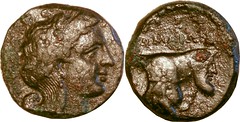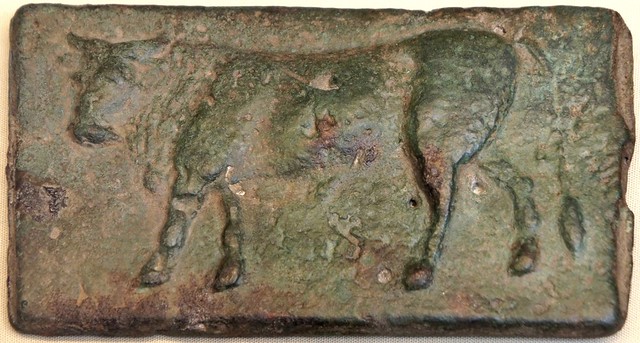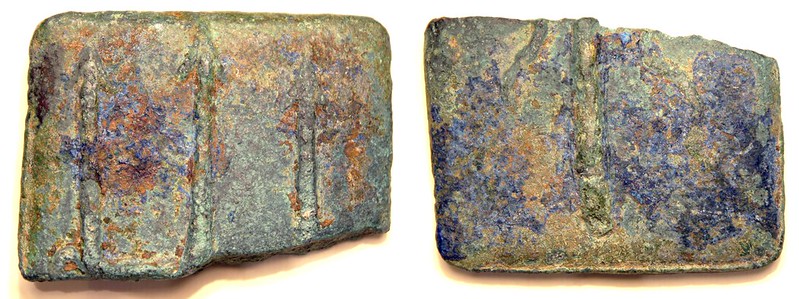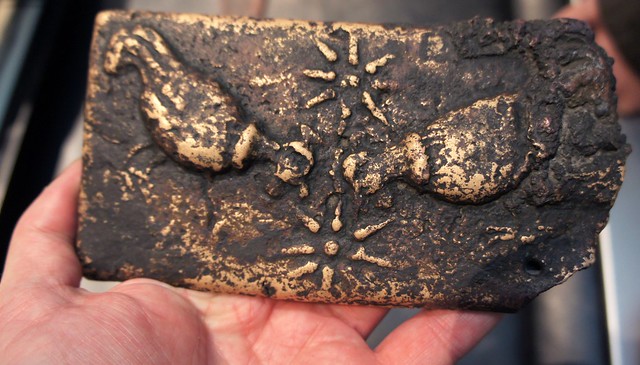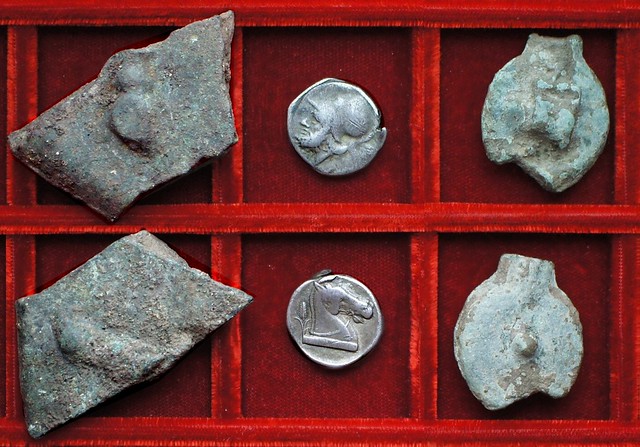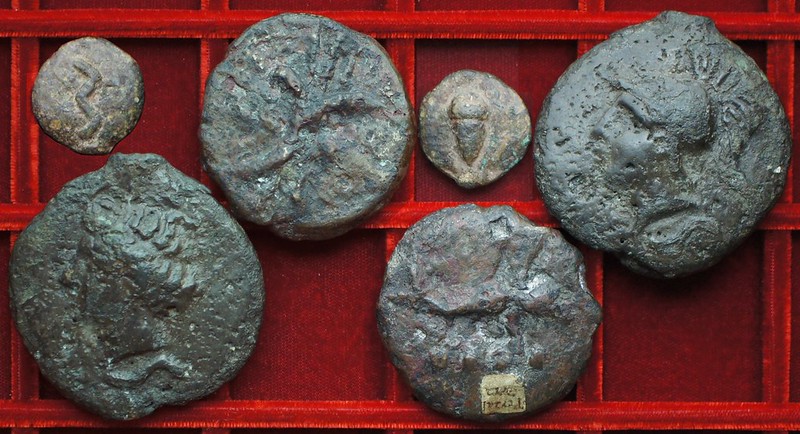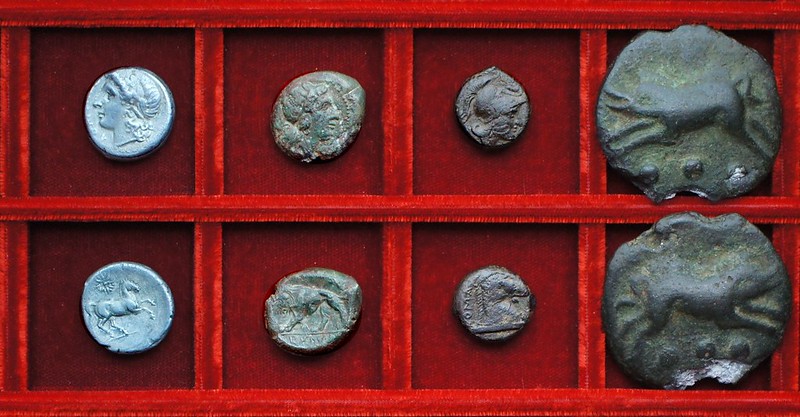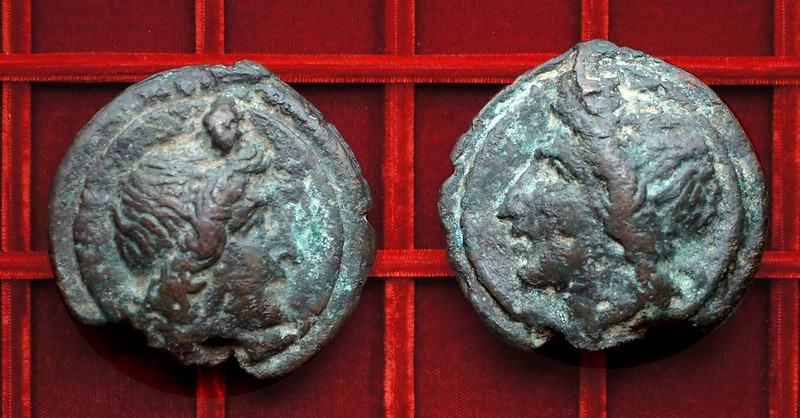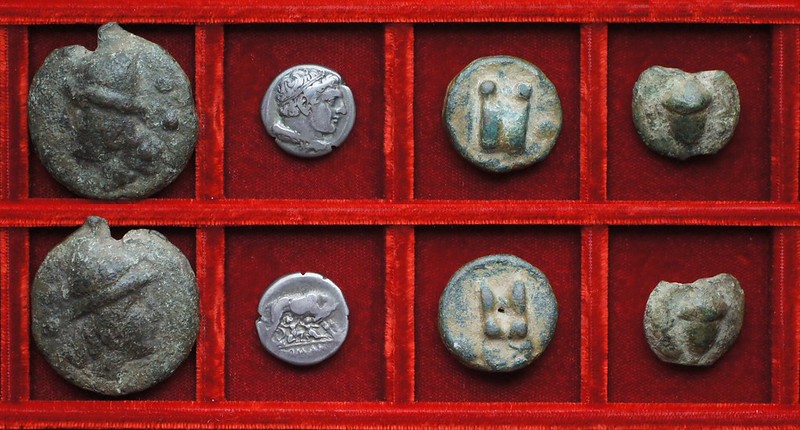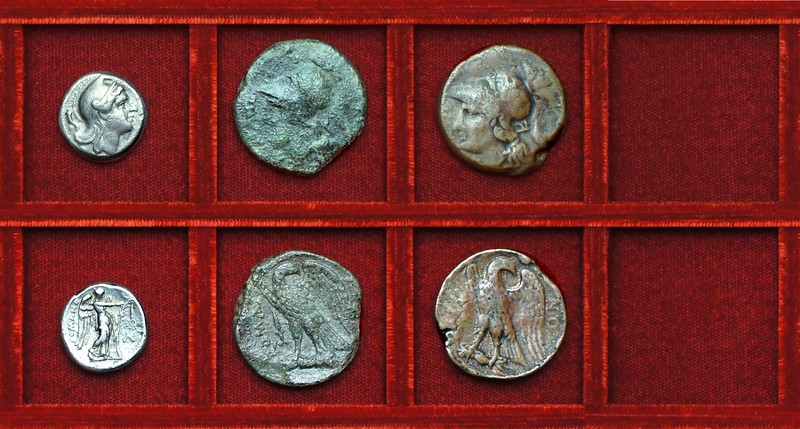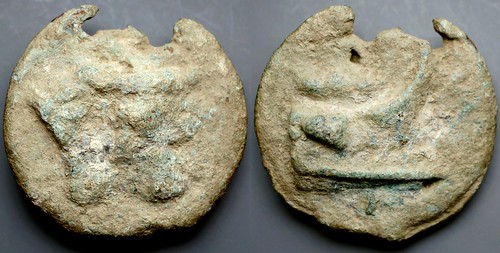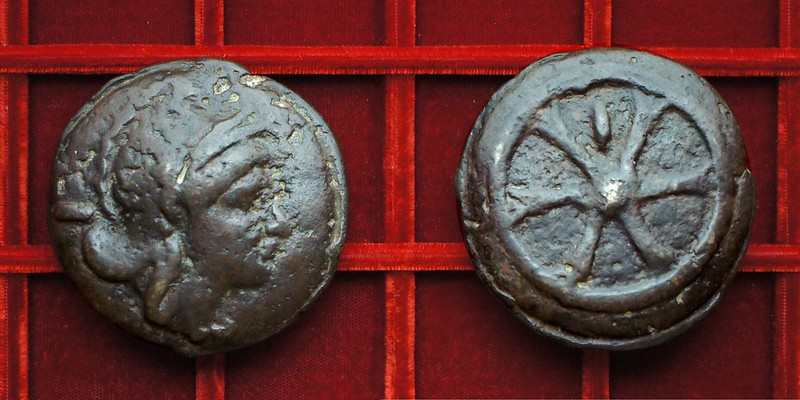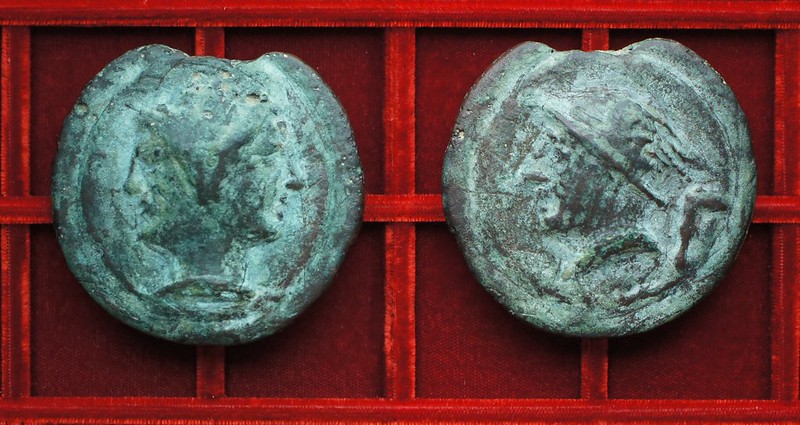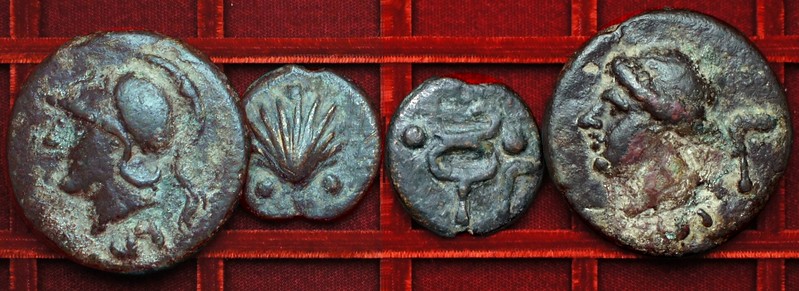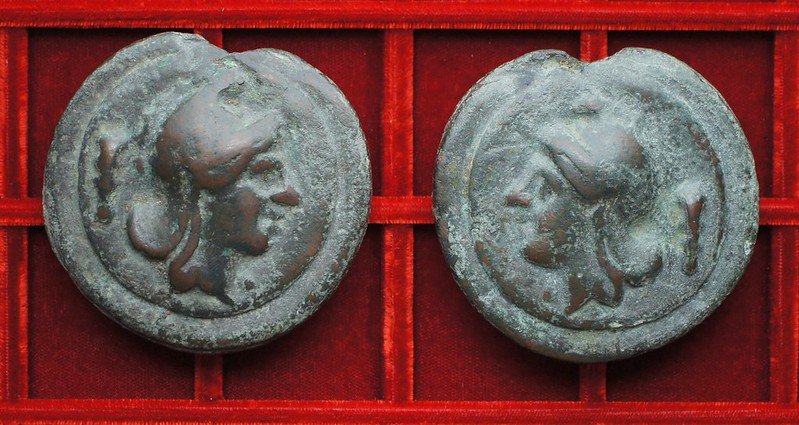Part 1: RRC 1 to RRC 27, 300 BC to 225 BC, Early Roman Coinage

|
Specialist Supplements:
1. Roman Coins of Luceria and Canusium
2. Anonymous Struck Bronze Coins of the Roman Republic
3. Anonymous Roman Republican Denarii and Victoriati (Steve Brinkman's site)
Principal Coins of the Roman Republic
General Introductory Comments
These web-pages show the complete Ahala Collection of Coins of the Roman Republic, consisting of 1200 coins of Aes Grave, Gold, Silver and Struck Bronze. The collection is representative of all eras of Roman Republican coinage, and includes many of the rarest types in all metals. The collection's intent is to show as good a cross-section as is possible, of the current money of the Roman Republic. Whilst the dominant coinage metal was silver denarius coinage, which constitutes about half of the Ahala collection, bronze coinage formed a high proportion of the circulating currency, particularly in cities and marketplaces, and was also used for military pay for a long period. Hence, many bronze types, both struck coin and Aes Grave, are included in the collection. Gold was not a predominant coinage metal during the Roman Republic, nevertheless a number of gold coin types are represented, from the two eras when it did circulate: the second Punic war, and the civil wars of the late Republic. The collection includes very many rare or unpublished coin types: it was deliberately formed with an academic purpose in mind. It is not intended to be comprehensive however - a comprehensive collection of Roman Republican coin types would require a collection of 5000 or 10000 pieces, such as that in the British Museum. The Ahala collection does however have a bias towards rarity, and as a consequence misses, in some cases, common types, which however can be readily accessed via other online sources. This presentation is biased towards coin illustrations and commentary that cannot be found anywhere else on the internet.
The collection is organised and illustrated strictly in accordance with Michael Crawford's 'Roman Republican Coinage', (hereafter RRC), and its scope is exactly that of RRC, with the addition, at the end of the series, of the coinage of Octavian that Sutherland showed to be contemporary with the later coinage of Mark Antony, and published as such in the revised volume 1 of Roman Imperial Coinage. Unpublished pieces are included in the most appropriate place in the RRC series; for example the dolabella series of bronze fractions is placed beside the RRC 81 Cn.Co dolabella issue, and an unpublished third series of the dolphin coinage is placed beside RRC 151 S.FVRI, which it most resembles in style. In many cases I draw on Roberto Russo's essay on unpublished Republican struck bronzes in Essays Hersh, and on his catalogue notes to the RBW collection, in NAC auctions 61 and 63.
An important feature of this presentation is that all the coins, from the tiniest silver sestertius, to the largest Aes Grave as, are presented to an identical scale, and this to-scale presentation can be easily verified by observing that all the coins are photographed on the same size background. This contrasts with the somewhat artificial presentation seen on most web-pages (including my own) that enlarge a silver denarius so it looks the same size as a bronze as. The wide range of coin sizes, many of which are very small, demands that I illustrate them at the largest possible size. All pictures are a band-width intensive 800 pixels wide; I ask your indulgence and a degree of patience if on a slower connection!
For this initial presentation, I present the coinage without substantial commentary, and even without detailed descriptions. The abbreviated descriptions refer to the RRC issue number, and I do not usually name the denominations, which are invariably self-evident. For detailed descriptions of the coins, please refer to RRC. I do however intend to include commentary on a per-issue basis over time, as I have the opportunity to do so.
Part 1: RRC 1 to RRC 27, 300 BC to 225 BC, Early Roman Coinage
The first period covers the didrachm and aes grave coinage before the second Punic war, i.e. from the earliest Roman coinage until the period of the libral prow-bronzes and quadrigatus coinage. Reductions in the bronze and debasement of the silver quadrigatus represent a change in the coinage that will be covered in Part 2.
RRC 0 Aes Rude pancake slab fragment, counterstamped. This is a segment from a large circular slab, the shape formed by the slightly rounded bottom of the crucible in which it was made. Counterstamps are a common feature on Aes Rude. There are a couple on this piece, most obviously an S shaped mark on the right hand side.

RRC 0 Aes Rude scallop shell, bar fragment akin 600BC Grammichele find. The scallop shell types equate approximately to the weight of a sextans, whose early designs always include a scallop shell. Knucklebone formed shapes also exist and match the types of an uncia. Were the cast scallop shells, undoubtedly made from the impression of a real shell, the precursors to uncia-based aes grave denominations, or were they produced in parallel with RRC 14 types, effectively home-made versions of the official aes grave coin? I do not know. The quadrilateral bar fragment is particularly interesting as its shape is unlike any aes signatum, but it does exactly match the bar fragments, dated by related pottery to about 600 BC, from Grammichele near Syracuse in Sicily. Was this bar part of the Grammichele find? Emilio Peruzzi suggests that the stamps on the Grammichele bar are actually the stamped bronze referred to in Pliny's tale of Servius Tullius having introduced bars stamped as cattle: i.e. branded as cattle would be branded. This bar fragment appears to have a helmet-shaped stamp on the right-hand picture that matches the helmet stamp reported on Grammichele bars. Much more on these ideas can be read on my web-page about Money in Early Rome.
RRC 1 ROMAION Litra. Apollo, Forepart man-headed bull. The FIRST Roman Coin minted in Naples, 326BC
RRC 5 Bull Bull Aes Signatum Quincussis Bar. On display in the British Museum
RRC 9 Elephant Sow Aes Signatum Quincussis bar commemorating victory against Pyrrhus at Beneventum 275BC. Pyrrhic elephants bolted from squealing pigs.
RRC 11 Trident Caduceus Aes Signatum Quincussis Bar 454 grams
RRC 12 Chickens Rostrum Tridens Aes Signatum Quincussis Bar 270BC. Two Chickens eating corn two stars, in my hands during a supervised Hands-On display in the British Museum; 1940s incendiary bomb damage at right
RRC 5 Bull Bull Aes Signatum bar fragment, RRC 13 Mars Horsehead Didrachm, RRC 14 Aes Grave uncia
RRC 14 Aes Grave Apollo Mercury As. This, the first ever aes grave coin, is of an extraordinary diameter with a very wide border and small neat devices unlike those used on later aes grave.
RRC 14 Aes Grave Apollo Mercury series semis, triens, semuncia. The triens has attached to it a cute old collector ticket, india ink on paper.
RRC 15 Apollo Horse didrachm, RRC 16 Goddess Lion, RRC 17 Mars horsehead, RRC 18 Aes Grave quadrans. The RRC 16 Goddess Lion type has the lion to the left rather than right. It is of the highest rarity, and not listed in Crawford's RRC, nor in Russo's update to Crawford, and is not mentioned in Bahrfeldt Nächtrage. I understand this coin to be unique in private hands or indeed in any hands outside Italy There are four examples in the Carsoli museum near Rome, out of the 174 examples found in a hoard discovered 1951 (the remaining 170 have lion right), and nine examples in the Museo Nazionale Roma out of 1156 coins in the 1854 Vicarello hoard (the remaining 1145 coins have lion right). This coin very likely also comes from the Vicarello hoard. The RRC 17 Mars Horsehead bronze is a scarce type with both Mars and the Horsehead facing in the same direction - on the vast majority of RRC 17 examples, the obverse head and reverse horse head face in opposite directions. The entire RRC 17 series may have beens struck at Cosa, whose coins share the type and metrology. I do not know where to place RRC 16; its fabric differs from RRC 17. The aes grave quadrans shows evident lead inclusions, in white, quite commonly seen in aes grave.
RRC 18 Aes Grave Apollo Apollo As
RRC 18 Aes Grave Apollo Apollo series semis, triens. RRC 18 is metrologically interesting: the weight standard is more than a Roman pound, in fact about 335 grams as compared with a Roman pound of about 324 grams. I do not know any satisfactory explanation. Compared with RRC 14, the as is almost three dimensional, with no flat surfaces at all, and extraordinary relief.
RRC 18 Aes Grave sextans, RRC 20 Hercules Wolf Twins didrachm, RRC 21 Aes Grave Roma-Roma series uncia, semuncia. The wolf and twins didrachm is widely accepted to be the first struck coin from Rome itself. Earlier didrachms are assumed to have been struck in Campania. RRC 21 Roma-Roma aes grave are the rarest of the main aes grave series, and the collection only contains lower denominations.
RRC 22 Diana Victory didrachm, RRC 23 Minerva Eagle bronzes, The dies of RRC 22 didrachms are all marked with Greek letters in a scheme which exactly mirrors that seen on Ptolemaic coinage of the era, which helps provide a terminus post-quem for the types. The RRC 23 Minerva Eagle bronzes are of very great rarity, so it's unusual to see two in a single collection. Behind the head of Minerva, and before the crest, is a varying symbol. This feature is not mentioned by Crawford and the symbols have not yet been listed. On the left hand coin the symbol appears to be a cornucopia (not previously known). The right hand coin shows a plough. The reverse is not a standard eagle-on-thunderbolt type as there also is a sword to the left of the reverse field. These coins are generally presumed to come from north-east Sicily or Bruttium, due to stylistic and metrological similarities with the coins of Messana, and the use of symbols as seen on coins of Bruttium.
HN Italy 359 Bull's head, Prow Aes Grave Semis. This rare and enigmatic type is very likely a first Punic war commemoration of the Roman victory at Mylae in 260 BC or Ecnomus in 256 BC. The prow is of an early type with a pointed rather than bulbous prowstem, hence the early date. There are no other associated denominations so this may have been a presentation piece to the marines involved in one or other battle. The bull is a typical symbol of power and wealth used on Roman coins. Whether this coin was made by the Romans as believed by Haeberlin and Thomsen, or by an allied city that probably supplied ships and marines to the Romans which is the view of Rutter in HN Italy and Vecchi in his new book on Aes Grave, is not of great importance; what is important is that it is the first prow bronze commemorating a Roman naval victory, and as such is an important coin in the history of Republican numismatics. Very rare, with few known find-spots.
RRC 24 Wheel Aes Grave As. The wheel types are of extraordinary simplicity and beauty: all denominations have value marks between the spokes of the wheels.
RRC 24 Wheel Aes Grave semis, triens, quadrans, sextans. This semis came from the 1965 auction of the Northwick Park aes grave collection owned by Captain Edward George Spencer Churchill, MC FSA, 1876-1964, a first cousin of Sir Winston Churchill, who became Lord of Harrow Manor in 1912. Northwick Park is Northwick Park, a 16th Century mansion house once owned by the Spencer Churchill Family. Such provenances add great interest to any coin.
RRC 25 Sickle Mars horsehead, didrachm, drachm, litra. The drachm type, indeed all silver fractions of the didrachm era, is of the highest rarity. The litra is of unusually attractive metal, a brassy copper with good surfaces. Most bronzes of the era are of relatively poor quality metal, and the nature of typical find contexts seems to make them prone to corrosion. Not this little gem!
RRC 25 Sickle Janus Mercury Aes Grave As. Contrast this coin with the above illustrated RRC 14 as, whose types it copies. The obverse heads are sometimes referred to as Janiform heads of the Dioscuri, rather than Janus, as the types are unbearded. However, the heads are bare, with visible hair and do not wear a pileus, the traditional cap of the Dioscuri, which would argue against them being the Dioscuri.
RRC 25 Sickle Aes Grave semis, triens, quadrans, sextans. RRC 25, with sickle, and RRC 27, with club, essentially mimic the types of RRC 14 and RRC 21, but are of lighter weight, based on an as of 280 grams. The didrachms of RRC 25 and RRC 27 also mimic earlier types, albeit not exactly, as Mars appears on both types, rather than Apollo as seen on the earlier prancing horse type, RRC 15. The didrachms are also of reduced weight, averaging 6.6 grams as against 7.2 grams for the earliest Roman didrachms.
RRC 26 Apollo Horse didrachm and bronze, Diana dog bronze, The tiny Diana dog bronze type is extraordinarily well engraved and made. The RRC 26 didrachm has had the word ROMA removed, presumably for jewelry use.
RRC 27 Club Mars horse didrachm and litra, and Hercules Pegasus double-litra. The Hercules Pegasus type is a coin of great beauty. Its type was adopted for a later semuncia of Luceria, that RRC classifies as RRC 27/4 but which surely must be a later issue.
RRC 27 Club Roma Roma Aes Grave As
RRC 27 Club Aes Grave semis, triens, sextans.
Specialist Supplements:
1. Roman Coins of Luceria and Canusium
2. Anonymous Struck Bronze Coins of the Roman Republic
3. Anonymous Roman Republican Denarii and Victoriati (Steve Brinkman's site)
All content copyright © 2004-2013 Andrew McCabe unless otherwise noted. If you've any questions or comments please contact me on the Yahoo Group RROME: http://groups.yahoo.com/group/RROME.
Alternately you can leave comments against any coin picture, just click on the picture and write in the comment box.
Site hosted free courtesy of VCoins.com
Ancient Coins on Vcoins
comment: this page is RRC001.html. June 2013 update.







